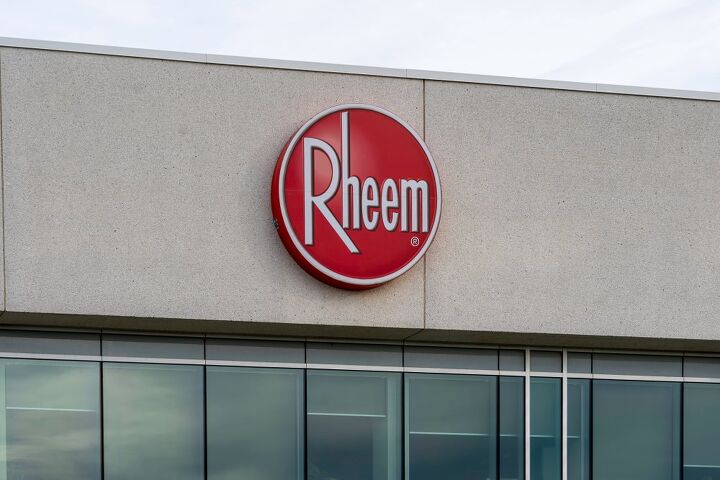Rheem vs. Trane: What Are The Major Differences?

If you’re in the market for new HVAC appliances in your home, the sheer number of products can be overwhelming. There are a wide variety of reputable brands as well as products with varying efficiencies and styles. Rheem and Trane are two of the country’s leading HVAC manufacturers.
Rheem manufactures furnaces, heat pumps, water heaters, and packaged systems. Trane offers a similar product line, manufacturing furnaces, heat pumps, packaged systems, and air handlers. When it comes down to it, the two offer similar quality products, but Rheem is much cheaper than Trane.
Before you decide based on Rheem’s appealing price tag, it’s essential to know more about each company. Knowing what each manufacturer offers will help you make an informed decision based on the product you need.
Do You Need a Heating and Cooling Contractor?
Get free, zero-commitment quotes from pro contractors near you.

Before We Begin: A General Introduction to HVAC Systems
Every home has an HVAC system of some sort. If you’re building a new home, you probably want to install top of the line appliances. If you’re simply replacing some old equipment, odds are you’re looking for something similar.
HVAC stands for heating, ventilation, and air conditioning and its primary goal is your comfort and air quality. An HVAC system should create an optimal thermal environment in your home and keep you breathing easy. A good HVAC system will keep you cool in the summer and toasty all winter long.
Not All HVAC Systems Are Created Equal
There are single and multi-stage systems, single systems consist of a furnace and air conditioning system. Multi-stage systems have multiple sources of cooling and heating. Multi-stage systems are more energy-efficient and tend to save homeowners money on electric bills.
Zoned systems set up your home into zones controlled by different thermostats. This type of system helps eliminate cold and hot spots. Zoned systems are great for saving money since they let you heat and cool individual rooms.
Heating systems vary as well, most being controlled by furnaces or boilers. Though, there are some options that you can even install under your floor to warm your feet.
Finally, you can find air conditioning systems as central systems or window units. Central AC is best for places that get particularly hot.
It is also important to note that air conditioners are ranked for their efficiency with SEER, or Season Energy Efficiency Rating. The higher the SEER, the higher the efficiency and the more cost-effective. You shouldn’t consider a system with a SEER lower than 13.
Humidity Controls
You can even add humidity controls to your HVAC system. This is especially helpful in areas of the country that are particularly dry or wet. Humidity controls will help to keep your home at the preferred 50% relative humidity.
Factors to Consider When Buying New HVAC Equipment
Before diving into an HVAC purchase, it’s important to consider several factors.
Think About the SEER Rating
As stated above, the higher the equipment’s SEER, the more efficient it will be. Buying a new appliance with a high SEER will save you money in the long run.
Consider Other Ratings
SEER isn’t the only method of rating HVAC equipment. There is also EER, or energy efficiency ratio, which reflects your HVAC system’s peak efficiency. HSPF, or heating seasonal performance factor, measures how efficiently a system heats.
AFUE, or annual fuel utilization efficiency, is a percentage that measures the efficiency of boilers and furnaces. For all these ratings, the higher the rating, the more efficient the appliance.
Make Sure to Get the Right Size System
Believe it or not, not every HVAC system will work with every size of home. A system that’s too large will waste energy, whereas a small system will minimize your thermal comfort at home.
Consider Costs
The lower price tag of a cheaper model may not be the best thing for your home. A more affordable model will most likely need more repairs and inspections than a more expensive model. Make sure to weigh purchase and installation costs with possible future repairs.
Think About Different Brands
There are lots of varying HVAC manufacturers out there with a variety of HVAC products available for purchase. Today, we’re going to compare Rheem and Trane, so you don’t have to!
Rheem vs. Trane: Heating Elements
How Do Their Furnaces Compare?
Rheem and Trane both offer over 20 furnace models. Rheem offers oil, natural gas, and propane-powered furnaces. It even boasts the industry’s lowest-emission furnace, the Rheem Classic Plus Series Ultra-low NOx 80% AFUE Upflow Gas Furnace.
Some of Rheem’s furnaces come with sensor technology that helps to regulate heating and boost efficiency. They also feature a PlusOne™ Ignition System and a diagnostics system for troubleshooting.
Trane offers one-stage, two-stage, and modulating furnaces. Trane’s top three furnaces range from 97% to 92% AFUE, significantly higher than Rheem’s Ultra-low NOx 80%. However, Rheem does have some higher efficiency models, around 96%.
Furnace Costs
Rheem’s furnaces range in price from $875 to $1,500. Trane’s furnaces are more varied in price with the low end near $1,800 and the high near $6,000.
The Winner: Rheem. With significantly cheaper units and similar AFUE ratings, Rheem furnaces give the most bang for your buck.
Rheem vs. Trane: Cooling Elements
How Do Their Air Conditioners Compare?
Rheem offers a decent variety of air conditioners with one and two-stage units that utilize scroll compressors for efficiency. Most have noise-dampening technology to keep a lower volume while it runs. The higher-end models even have humidity control.
Trane air conditioners have high SEER, many with an ENERGY star rating, and low noise levels. This means Trane air conditioners are highly efficient, better for the environment than most brands, and quiet. The top three Trane air conditioners have SEER from 16 to 20.
Air Conditioner Costs
Rheem air conditioners cost anywhere from $1,000 to $2,400. Trane air conditioners cost between $6,000 and $10,000.
Winner: Trane. The combination of the high ratings and noise dampening technology puts Trane above Rheem here.
Rheem vs. Trane: Heating and Cooling Elements
How Do Their Heat Pumps Compare?
Heat pumps both heat and cool your home by redirecting hot air. In the summer, heat pumps move hot air inside your home outside. In the winter, heat pumps move heat energy from the outside air inside your home.
Rheem offers six different heat pump models to choose from. Trane has Rheem beat in sheer numbers, providing a whopping 11 options. Rheem’s heat pumps come in one-stage, two-stage, and three-stage operating systems.
Both manufacturers offer technology on their heat pumps that increase their efficiency. Five of Rheem’s heat pumps use a scroll compressor that allows them to compress air more efficiently. Trane’s heat pumps come with a feature that adjusts for drastic temperature changes, known as the Trane Climatuff® Compressor.
Trane’s heat pumps have relatively high SEER and HSPF ratings, the former reaching as high as 20 and the latter up to 12.
Heat Pump Costs
Rheem’s heat pumps range in price from $1,200 to $2,200. Once again, Trane is pricier, ranging from $4,800 to $10,000.
Winner: Tied. Trane offers more variety but is significantly more expensive.
Rheem vs. Trane: How Do Their Packaged Systems Compare?
Packaged systems are units made for smaller spaces that both heat and cool homes. These are best for homes that don’t have room inside for a furnace or air handler.
Rheem offers 18 different packaged system options. Some are two-stage systems, while others operate with scroll compressors. Some even provide humidity control for maximum comfort.
Trane has four packaged system types: gas-electric, heat pump, Earthwise hybrid dual fuel, and air conditioner. There are three gas-electric options that each act as an AC in the summer and furnace in the winter.
The four heat pump options act as a heating and cooling system. The two Earthwise hybrid dual fuel options are incredibly energy efficient. The AC packaged system options are perfect for areas with warm weather.
Packaged Systems Costs
Rheem packaged systems cost between $2,500 and $3,500. Trane packaged systems range from $3,300 to $6,000.
Winner: Tied. Both offer a significant variety of packaged systems with similar abilities.
Rheem vs. Trane: Air Quality
When it comes to your HVAC system, it’s essential to have one that ensures excellent air quality in your home.
Rheem provides advanced filtration in their air cleaners, reducing pollutants, pollen, and dust as air passes through. Trane provides a similar level of air quality with its air cleaners.
In fact, one of Trane’s systems, the CleanEffectsTM system, achieved a major first. It was the first whole-home air cleaning system to be given the asthma & allergy friendly® Certification Program mark.
Winner: Trane. The asthma & allergy friendly® Certification Program mark makes its air cleaners a great fit for homes.
Rheem vs. Trane: Maintenance and Average Lifespan
Most Rheem products are meant to last 15 or more years. Trane products have similar life expectancies, most lasting between 15 and 20 years. The lifespan of both can be affected by how well you maintain your products.
In both cases, you should perform annual maintenance checks once a year to ensure nothing is starting to deteriorate. Having an annual inspection can lead to a need for fewer repairs.
Winner: Tied. Both products have similar lifespans.
Related Questions
Will the HVAC system I choose influence who installs it?
Before purchasing a Rheem or Trane product, make sure your HVAC professional is familiar with the unit you intend to purchase. Some pros are only familiar with certain brands. Ultimately, the system you choose could determine who’s installing your new unit!
Do Rheem and Trane come with similar warranties?
Rheem offers a 10-year limited parts warranty on the majority of its products. For some heat pumps, Rheem offers a 10 or 5-year conditional unit replacement warranty. All the heating and cooling systems Trane offers come with a Base Limited Warranty. This warranty covers parts that break due to defects for anywhere from 1-20 years. You can register your Trane product in the first 60 days to get a longer warranty.
Do You Need a Heating and Cooling Contractor?
Get free, zero-commitment quotes from pro contractors near you.

Our Final Take
When it comes down to it, Rheem and Trane offer a similar variety of products. They both manufacture practically everything you need to heat and cool your home. Whether you go with Rheem or Trane, you won’t have to worry about missing a crucial piece of an HVAC system.
Rheem and Trane both offer a broad spectrum of products, though occasionally, one edges the other out in numbers. This variety means you have lots to choose from. No matter which brand you choose, there will probably be something in your price range.
Rheem products are significantly cheaper than Trane products. However, this does not necessarily mean that Trane products are better than Rheem. The manufacturers were comparable in terms of ratings and efficiency.
Really, it all comes down to you and your needs. If the bigger price tag is too much of a concern, lean toward the lower-priced Rheem products. If you’re looking for systems with high ratings and lots of certification marks, Trane is the way to go.
Related Guides

Stacy Randall is a wife, mother, and freelance writer from NOLA that has always had a love for DIY projects, home organization, and making spaces beautiful. Together with her husband, she has been spending the last several years lovingly renovating her grandparent's former home, making it their own and learning a lot about life along the way.
More by Stacy Randall



























